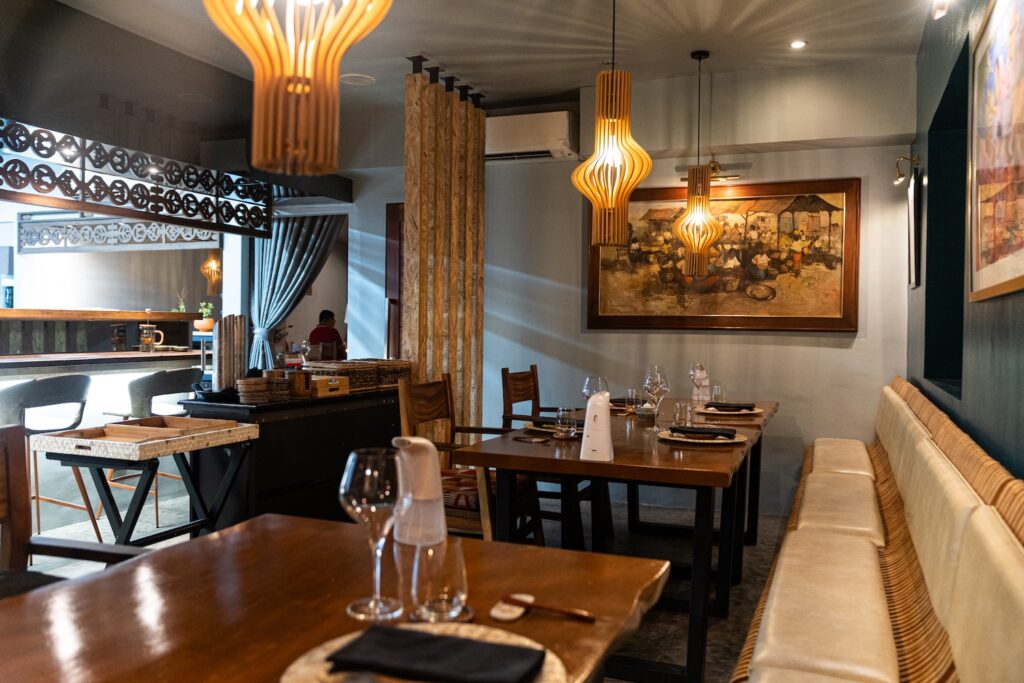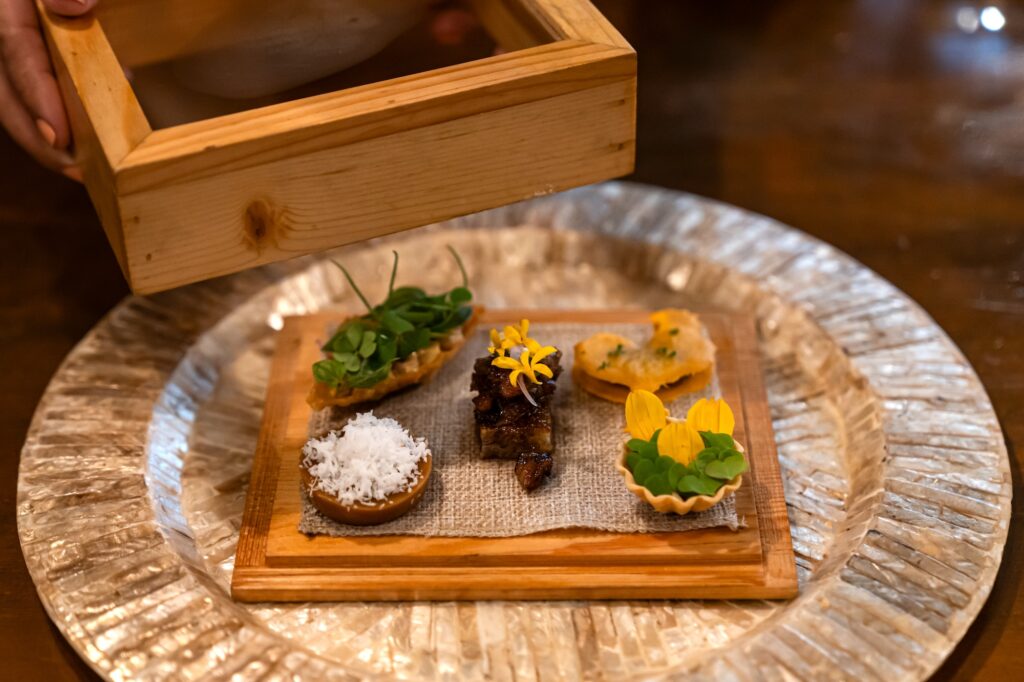Can you boil down your entire history into a single defining moment? Apparently you can, as Hapag proves just that.
And they do it in a way that speaks of peak millennial energy, compressing their legacy dubbed “Greatest Hits” into a physical CD format that guests take home as a parting gift.
Hapag’s “Greatest Hits” is both a headliner and a curtain call for the restaurant that “let people eat in a setting where they will respect the food” before their anticipated transfer to Rockwell.
Sure, Kevin Navoa, Thirdy Dolatre, and the entire team may be moving to a new location but they aren’t going anywhere.
Sure, Kevin Navoa, Thirdy Dolatre, and the entire team may be moving to a new location but they aren’t going anywhere. Filipino cuisine is still the order of the day (or night) for Hapag’s “Greatest Hits” menu, which is an homage to the best things to ever come out of the Katipunan kitchen—from dishes that trace their roots to the beginning and the family meals they crafted at the height of the pandemic to the recent favorites from their Ayá pop-up—only done up with flourish.
“We did this basically to pay respects to the space,” says Navoa. “We’ve been here for four and a half years and it’s just fitting to pay respects to the place… for everything that’s been on the menu.”
Constructing the future, challenging Hapag as we know it


Four years in music might not normally be enough to compile a greatest hits album but in the restaurant industry, four years is an eternity. Four years of wrestling with the universal and the personal, expectations and pressures, and a pandemic and mere existence have all culminated into the closing of a chapter—at least before Hapag’s next adventure.
“The idea of the new restaurant is to reinvent and rethink the whole idea of the restaurant but just changing the approach,” says Navoa. “Risky pero we’ll have to find out.”
Building a new restaurant out of a “dramatic” yet homey space filled with Philippine textiles, reveals Dolatre, is never easy even for seasoned veterans but they seem to relish the uphill climb. “It’s harder now because when we opened this space, we did not care about a lot of things,” says Navoa. “Gusto lang namin magluto. Now the new space has many moving parts.”
Following their foray into a well-loved but short-lived pop-up at Balmori Suites, Dolatre and Navoa’s relocation to Rockwell marks the logical next step for Hapag.
Four times the size of the original restaurant, the new Hapag, Navoa says, gives off the feeling of home (albeit with a meticulously crafted interior design that’s caused them to push back the opening several times) where the ground floor would be fertile grounds for themed tasting menus and the upstairs would be all Ayá—Filipino-style a la carte and tapas with cocktails and wines led by beverage manager Erin Ganuelas.
“The kitchen will still be open but it will be as big as the old Hapag restaurant, if not a little smaller,” shares Navoa
And this time around, pressure is making its presence felt but they don’t appear to capsize under its weight. “Pressured?” asks Navoa. “Pressured to open na kasi we’re going to be paying rent.”
“Pressured to open,” clarifies Dolatre. “Actually ’yun ’yung nakakapressure.”
“There’s a lot of pressure when you think about it kasi when we open this time, may expectations na compared to this na no one knew what the fuck this was…” shares Navoa. “But with a team like this and the maturity we’ve had the past few years I think we’re okay. More than anything, the menu isn’t the problem, it’s really building the restaurant. Na-experience namin ’yung Rockwell sa Ayá, it’s a whole different ball game.”
But with a couple months left to lay down the foundations for the new space, Hapag has proven time and again that they can lock down into the groove once they get going—all while creating an introspective centerpiece that is their “Greatest Hits” menu.
Past lives couldn’t ever hold them down
Launched on Sept. 6, what piques your attention about Hapag’s “Greatest Hits” menu is that while it does celebrate the past, it definitely looks forward to what’s next.
The collection is like putting a Hapag playlist on shuffle with bangers and palate-pleasers, covering their introduction in 2017 to a sort of fairytale end in 2023. Preserved in CD format, their greatest hits collection lists the courses as well as the suppliers and the names who have made Hapag what it is now.
The dishes aren’t arranged chronologically but they all focus on a certain Hapag characteristic that shows the strength of their era-defining food and how their modern take on Filipino food stands the test of time.
For anyone who has never had the chance to traipse to Katipunan, now is the time to put down a reservation and own the “album.” It’s aimed at those who have never experienced the restaurant and those who may want to fulfill a final farewell to Hapag as we know it.
The dishes aren’t arranged chronologically but they all focus on a certain Hapag characteristic that shows the strength of their era-defining food and how their modern take on Filipino food stands the test of time. No mean feat for a menu that arguably doesn’t follow a traditional template.
Hapag and its greatest hits is a wistful collection that washes over you
At 10 courses, the menu is brief but intense. Familiar but still feels fresh. The pretty plates rouse our appetites and remind us of the beauty of impermanence. That these may no longer exist in the new space is “mono no aware” (the Japanese concept that believes everything is transient) put into practice.
The pan de kalinga opens the affairs with a simple swagger—in the form of a fermented black rice sourdough served with sweet potato halaya and Davao dark honey butter—but it’s on the innovative snack box where they ricochet in new directions to show off every flavor in their textbook and serve as an entry point for Hapag’s ethos.
It is one of their finest achievements on the menu: a warek-warek made with pork instead of goat and drizzled with dinakdakan crema, a cheeky crispy inasal cracker that crackles with the sukang Iloko, a soy caramel kutsinta made with six-month kadyos shoyu and finished with coconut meat, a triumphant one-bite pares toast with chimichurri and roasted garlic aioli, and a deliciously earthy keso and kabute tart where a fermented cashew-miso mousse mimics cheese and melds with a smoked mushroom confit for an intoxicating dose of creativity.
It’s a maelstrom of regional styles and substantial flavors that speaks to their abilities as chefs and inherent interest in exploring new territories. Particularly when it comes to fermentation (their kitchen features a “fermentation shelf”) that eventually became a passion project during the pandemic. “We realized that it became the backbone of our food,” says Navoa.
While the kinilaw na tuna sa pakwan delves more into sweetly acidic tendencies, classics such as the beautiful laing stones (now all grown in its pot and decorated with cashew soil, coconut cream leaves, and sugary twigs) and the subtle climax of the sugpo at buro plucked from the 2020 menu are as flashy as ever.
Elsewhere, the uni arroz caldo, as delicate as it is, carries a weight of briny flavors from the fresh urchin and fermented ube katsuobushi. After this cathartic daintiness, the punchy main salu salo course pumps up the table with the perfect confluence of the land and the sea, and one meant to be shared and digested with gusto—a pork belly cured in aromatics for 12 hours cooked sous vide and finished on the grill, a three-day aged tanigue served with a kadyos sauce, and finally a kare-kare made with beef short ribs cashew sauce.
Moments later, the selection of desserts—from the strawberry taho and its bright tasting mulled wine arnibal to the Northern Philippine banana merienda of ginanggang and even the trio of katmon kababayan, miso sylvanas, and champorado at tuyo—finds Hapag expressing a sincerity and a feeling of contentment that, after partaking in the entire meal, no encore is needed.
An end-of-an-era feeling
What makes this collection successful is that each selected dish has a place in the history of Hapag. And when every young chef and server comes to the table to explain the dishes, it harks back to what both Navoa and Dolatre have learned throughout the years running this little restaurant.
“Taking care of staff. ’Yun ’yung number one na naging game-changer for me personally,” admits Navoa. “If we empower them and invest in them also, mas nag-e-evolve ’yung restaurant as opposed to having people coming to work just to work.”
“Taking care of staff. ’Yun ’yung number one na naging game-changer for me personally,” admits Kevin Navoa. “If we empower them and invest in them also, mas nag-e-evolve ’yung restaurant as opposed to having people coming to work just to work.”
Speaking with such fondness, Dolatre says, “Iba ’yung may purpose sila. Most of our staff now dumaan sa internship program namin. Ang dami sa kanila nag-de-decide mag-stay.”
And why wouldn’t they? Drenched in nostalgia and hope, Hapag’s “Greatest Hits” and the restaurant itself is as catchy as any pop gem chorus there is—and heads, hearts, and guts sure are singing along.
The only “drawback” is, the longer they stay in the game, the faster they feel the environment and generation changing.
“Nakakatanda pala,” acknowledges Navoa. “I feel 10 years older.”
“I don’t,” laughs Dolatre.

